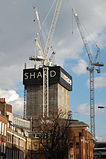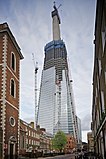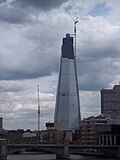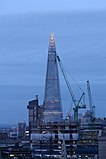
The Shard
The Shard,[a] also referred to as the Shard London Bridge[12] and formerly London Bridge Tower,[13] is a pyramid-shaped 72-storey mixed-use development supertall skyscraper, designed by the Italian architect Renzo Piano, in Bermondsey, London, that forms part of The Shard Quarter development. Standing 309.6 metres (1,016 feet) high, The Shard is the tallest building in the United Kingdom, the seventh-tallest building in Europe, and the second-tallest outside Russia behind the Varso Tower in Warsaw, which beats the Shard by less than half a metre.[14] It is also the second-tallest free-standing structure in the United Kingdom, after the concrete tower of the Emley Moor transmitting station. The Shard replaced Southwark Towers, a 24-storey office block built on the site in 1975.
For other uses, see Shard (disambiguation).The Shard
Shard London Bridge
Completed
London, England
16 March 2009
5 July 2012
1 February 2013
~£435,023,452 (contract cost only)
State of Qatar (95%)
Sellar Property Group (5%)
309.6 m (1,016 ft)[10]
244.3 m (802 ft)
95 (72 habitable)
36[11]
WSP Global (structural engineers), Robert Bird Group (concrete temporary works), Ischebeck Titan on most floors 40+ (concrete support)
The Shard's construction began in March 2009; it was topped out on 30 March 2012 and inaugurated on 5 July 2012. Practical completion was achieved in November 2012. The tower's privately operated observation deck, The View from The Shard, was opened to the public on 1 February 2013. The glass-clad pyramidal tower has 72 habitable floors, with a viewing gallery and open-air observation deck on the 72nd floor, at a height of 244 metres (801 ft). The Shard was developed by Sellar Property Group on behalf of LBQ Ltd and is jointly owned by Sellar Property (5%) and the State of Qatar (95%).
Background[edit]
Planning[edit]
In 1998, London-based entrepreneur Irvine Sellar and his partners decided to redevelop the 1970s-era Southwark Towers following a UK government white paper encouraging the development of tall buildings at major transport hubs. Sellar flew to Berlin in the spring of 2000 to meet the Italian architect Renzo Piano for lunch. According to Sellar, Piano spoke of his contempt for conventional tall buildings during the meal, before flipping over the restaurant's menu and sketching a spire-like sculpture emerging from the River Thames.[15]
In July 2002, the Deputy Prime Minister, John Prescott, ordered a planning inquiry after the development plans for the Shard were opposed by the Commission for Architecture and the Built Environment and several heritage bodies, including the Royal Parks Foundation and English Heritage.[16][17] The inquiry took place in April and May 2003,[13][18] and on 19 November 2003, the Office of the Deputy Prime Minister announced that planning consent had been approved.[19] The government stated that:
Initial tenants[edit]
The Shard comprises a 26-floor office complex, occupied by 32 companies across 10 business sectors, 3 restaurants—Aqua Shard, Oblix, and Hutong—the five-star Shangri-La The Shard, London hotel, 10 residential apartments, and the UK's highest viewing gallery, The View from The Shard.
In February 2013, The Sunday Times reported that the developers of The Shard were in negotiations to secure the first tenants of the building's 26 floors of office space. At the time, potential tenants included financial restructuring specialists Duff & Phelps, private equity firm Hatton Corporation, and the South Hook Liquefied Natural Gas Company.[58][59]
The Shard's fourth, fifth, and sixth floors host the HCA (Hospital Corporations of America), part of London Bridge Hospital. The Shard's 31st, 32nd, and 33rd floors host three restaurants: Oblix,[60] Hutong,[61] and Aqua Shard.[62] The building's Shangri-La Hotel occupies floors 34–52.[63] The hotel was initially expected to open by the end of 2013,[64][65] but its opening was ultimately delayed to 6 May 2014.[66] In March 2014, Mathys & Squire became the first law firm to take tenancy in the building.[67][68] In May 2014, the Foresight Group, an investment firm, moved its head UK office into The Shard on the 17th floor.[69] In June 2015, Warwick Business School opened its new base in The Shard, occupying the same floor and was officially opened by the mayor of London, Boris Johnson.[70] It houses a 100-seat lecture theatre and a smaller one at 60 seats, plus 8 seminar rooms and an IT lab, offering postgraduate and executive education.[71]
In July 2013, the Qatari broadcaster Al Jazeera Media Network announced that it would open a new television studio and newsroom for Al Jazeera English in The Shard.[72] Al Jazeera moved in on 13 September 2014; its first live broadcast from the building was on 10 November 2014.[73] The facility currently houses all primary operations for Al Jazeera Media Network's channels in London; it is capable of running an entire channel independent from Al Jazeera's other hubs, and is the network's second-biggest hub after its facility in Doha, Qatar.[74]
In January 2015, further tenants for The Shard were announced, including IO Oil & Gas Consulting, Gallup, and The Office Group.[75] In May 2015, the American recruitment consultancy Robert Half International announced that it would move several branches of its business into The Shard, having purchased 20,000 square feet (1,900 m2) of floor space on the tower's tenth floor.[76] In August 2015, the international law firm Greenberg Traurig announced that it would open its offices on the eighth floor of The Shard by the end of the year.[77]
Matches Fashion took over 35,000 sq ft in January 2016, and six months later expanded its headquarter's presence in The Shard by 40%. In March 2016, marketing agency Jellyfish signed a lease for 9,017 square feet (837.7 m2) of office space on the 22nd floor, with occupancy beginning later in the year.[78] A month later, publishing house Dods Group let almost 17,000 square feet (1,600 m2) on Level 11, becoming The Shard's 28th office occupier. In December, Kraft Heinz relocated their European and UK headquarters from Hayes in Hillingdon to The Shard after taking 38,000 square feet (3,500 m2) on Levels 20 & 21.
The Shard offices were announced as fully let in October 2017, following lettings to Mitie and existing occupiers, Foresight Group, and Warwick Business School.
Urban exploration, BASE jumping, and climbing[edit]
In December 2011, a group of recreational explorers calling themselves the Place Hackers evaded security and made their way to the top of the Shard building site, climbing one of the tallest cranes in the process.[79] They later posted photographs of the London skyline taken from the top of the Shard on the Internet and received wide media attention. One member of the group, Oxford University researcher Bradley Garrett, later revealed to various news outlets that over 20 urban explorers had made their way to the top of the building during its construction.[80] In a 2012 article for Domus magazine, Garrett wrote that "the conceptual barrier to places in our cities is brought about by a process of engineered exclusion" and that the explorers were "cultivating the creative city that money can't buy".[81]
BASE jumpers reportedly jumped from The Shard over ten times between 2009 and 2012. Four jumps were reportedly made by Dan Witchalls, who had filmed one attempt. The highest jump was said to have been from a height of 260 metres (850 ft).[82] In March 2016 another person BASE jumped from The Shard.[83]
On 3 September 2012, a team of 40 people, including Prince Andrew, Duke of York, abseiled from the tower's 87th floor. This feat was performed to raise money for the Outward Bound Trust and the Royal Marines Charitable Trust Fund.[84][85] In November 2012, the French urban climber Alain Robert was spotted in the building by security guards. At the end of the month, the Shard's owners won an injunction to prevent him from entering or climbing the building.[86]
On 11 July 2013, six Greenpeace volunteers climbed the Shard and unfurled a flag in protest against Arctic oil drilling by Royal Dutch Shell.[87] The protestors announced they were "experienced climbers", but medical personnel were summoned to the base of the tower nonetheless.[87] The Shard's staff closed the tower's observatory and gave them a safety briefing and other advice during their climb.[87] After completing their 16-hour climb, the protestors were arrested by police on suspicion of aggravated trespass.[87]











